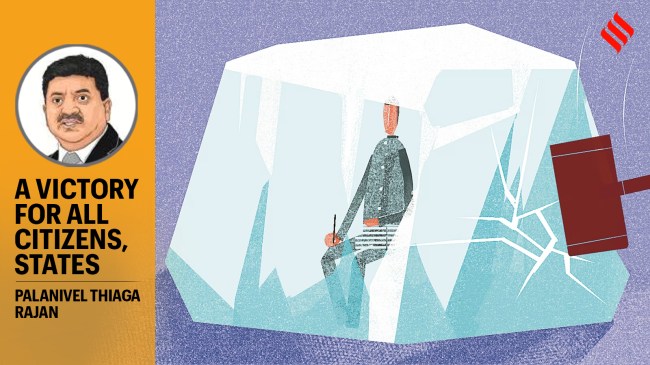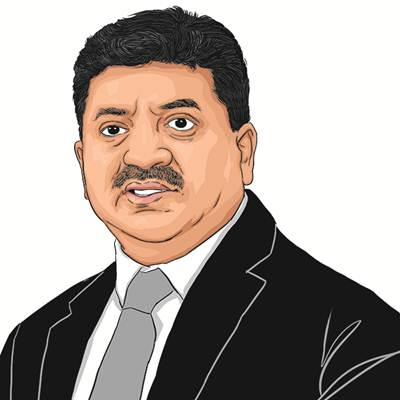Opinion With verdict on Governor R N Ravi, Supreme Court gives Indian states — and India — a victory
Supreme Court’s ruling in strengthens federalism and will hopefully put us on a path towards a united, progressive future.
 Perhaps of greatest impact is the establishment of clear time frames for the possible actions of the Governor, and the President, under Articles 200 and 201 of the Constitution — this brings unprecedented clarity. (Illustration by C R Sasikumar)
Perhaps of greatest impact is the establishment of clear time frames for the possible actions of the Governor, and the President, under Articles 200 and 201 of the Constitution — this brings unprecedented clarity. (Illustration by C R Sasikumar) The Supreme Court judgment delivered on April 8 in State of Tamil Nadu vs The Governor of Tamil Nadu and Another, marks a golden day in the history of India. It is a landmark judgment in strengthening federalism as the basis for the Indian Constitution — the “Union of States” concept enshrined in law.
Our founding fathers wrote the Constitution as a vision statement of how we govern ourselves rather than an operational manual. This has required a lot of interpretation and operationalisation over time — a fact attested in the more than 100 amendments we have had in the last 75 years, as well as several landmark Supreme Court judgments.
Since 2014, capitalising on the operational grey areas in the Constitution, the Union government has attempted an unprecedented centralisation of power along with constant interference in the functioning of democratically elected state governments — most often through the appointment of obdurate governors to states where the NDA has not been elected to office.
Such actions have led to multiple states approaching the Supreme Court seeking justice, or at least reprieve, from the actions of their governors. For example, Kerala has had to take its Governor to court. Punjab did the same and won — including for a matter as routine as the Governor interfering with the convening of the Assembly session. This judgment, based on a similar litigation by Tamil Nadu concerning 10 bills that the Governor had held in abeyance for years, greatly limits the ability of governors to obstruct state legislation, and thereby removes a lacuna in the procedural implementation of the Constitution, which has been exploited unscrupulously in the past.
Judgments like this refine the interpretations of the Constitution and provide operating guidelines. At one level, this is a simple extension of the judgment delivered by the SC in November 2023 in State of Punjab vs Principal Secretary to the Governor of Punjab and Another, where it reaffirmed that in a parliamentary democracy, real power lies with elected representatives, and that the Governor cannot indefinitely withhold his assent to bills or obstruct the legislative process. But at another level, several aspects of this landmark litigation merit detailed attention. First, the duration for which the 10 bills had been kept pending was an aggravated assault on democracy. The first obstructed bill dates back to 2020, and was passed by the then AIADMK administration. It renamed the Tamil Nadu Fisheries University after the former chief minister J Jayalalithaa. All the bills relate to universities, whose functioning has been deeply affected by the Covid crisis. What universities vitally require in their attempts to recover are firm hands and immediate governance, not the deep freeze that came from the Governor’s inaction.
Second, we must applaud the magnanimity and wisdom of Tamil Nadu’s Chief Minister M K Stalin in re-passing all 10 bills verbatim, irrespective of their content or the government (AIADMK or DMK) that had originally introduced the bill. The Supreme Court’s judgment makes a clear distinction: When an identical bill is resubmitted to the Governor, withholding assent becomes constitutionally impermissible; however, an amended bill remains subject to potential rejection again. Our Chief Minister recognised that this matter transcended politics — it was vital to states’ rights and federalism. His principled approach secured us a decisive legal victory, as the universal re-passing and resubmission of all 10 bills strengthened our case.
The third remarkable aspect of this judgment is the Supreme Court’s exercise of its extraordinary powers under Article 142 of the Constitution. By declaring these bills as being deemed to have been assented to on the day they arrived at the Governor’s desk after re-passing by the Assembly, the Court has taken a decisive step to protect legislative processes from administrative obstruction. While some purists lament the Court’s rare foray into executive action, it is beyond any debate that these actions were forced upon it by the extraordinary actions of the Governor’s office throughout the court proceedings — these revealed a troubling pattern of procedural jugglery. When judicial scrutiny was attracted to bills that had languished for years, he hastily returned them to the legislature marked “consent withheld”, in an apparent attempt to render the hearing infructuous. After the bills were re-passed, an absurd argument was put forth that because only photocopies were returned while the originals remained at the Raj Bhavan, the legislature lacked authority to repass them. When the Punjab ruling made it clear that there is no unlimited power to sit on such bills, the re-passed bills suddenly got sent to the President for review. At every turn, the Governor tried to subvert both the intent of the legislature and the judicial review of his actions. This has compelled the court to explicitly state in paragraph 432 of the judgment that “The conduct exhibited on part of the Governor……has been lacking in bonafides.”
Perhaps of greatest impact is the establishment of clear time frames for the possible actions of the Governor, and the President, under Articles 200 and 201 of the Constitution — this brings unprecedented clarity. Despite comprising merely 10 lines of text, the interpretation of this article has varied widely throughout India’s 75-year constitutional history, frequently leaving it vulnerable to misuse. This notion of a time frame, defined for the first time since the Constitution was adopted in 1950, ranks this judgment alongside the Kesavananda Bharati (1973), and S R Bommai (1994) judgments, which have proven vital for our Republic. It is more impactful and legally elegant than the electoral bonds case, which, though it declared the bonds illegal, neither cured the negative consequences of the thousands of crores of the now-unconstitutional bonds, nor forced any penalties.
The judgment has affirmed the principle that no individual — elected or unelected — should have infinite power to limit the functioning of a government elected by the will of the people. By explicitly stating that the President and Governors do not have the powers of either absolute veto or pocket veto (indefinite delay without action), and that the actions of both are indeed subject to judicial review, the Court has upheld a core tenet of democracy — no person is above the law. It would be an insult to our founding fathers if the President of India were to have greater powers (to effectively withhold assent permanently from legislation passed by a legislature elected by the citizens) than the King of the United Kingdom — the very colonial power we fought to become independent from.
The Supreme Court’s decision is a victory for all citizens and all states. It is a victory for the notion of federalism, and for India — it has the potential to put us on a different path than that of the past decade. One that leads to a united, progressive future for all states and our country.
The wisdom and sagacity of our Chief Minister has brought us to this important juncture. We must think about this in the context of what is happening in the world right now — markets melting down, a return to parochial interests and the breaking of global trade patterns. This is a chance for India to shine. For our nation to realise its potential, we need the States and the Union to work collegially.
The writer is Minister for Information Technology and Digital Services, Tamil Nadu






